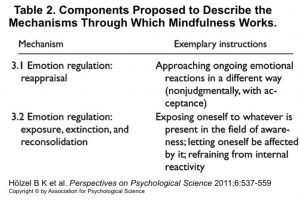This is the third of four posts about how mindfulness works, or the documented effects and how they occur. The first was about attention regulation, the second body awareness, and now we turn to emotional regulation.
A man riding a horse approaches a man standing by the side of the road. The bystander asks where the rider is going, and the rider responds, “‘I don’t know. Ask the horse'” (Tan, 2012, p. 104). Chade-Meng Tan tells this story to illustrate the notion of emotional regulation, affirming that the rider “can tame and guide the horse,” just as we can learn to “skillfully” work with our emotions. This skill helps us–in the wake of negative thoughts or experiences–become a) less emotionally and physiologically reactive, or at the mercy of immediate, habitual responses; and b) more resilient, able to bounce back.
The connections between mindfulness and emotional regulation have been documented in studies through self-reports, physiological measures, and neuroimaging (Hölzel, 2011). Emotional regulation occurs in the prefrontal cortex (more activity in this area that monitors and regulates thoughts, emotions, and behaviors) and in the amygdala (less activity in this area that detects and reacts to stimuli that arouse emotions). Mindful practice activates these same regions in the very same ways. As Tan explains, “Mindfulness helps our thinking brain and our emotional brain communicate more clearly to each other, so they work better together” (p. 115).

Click to enlarge this excerpt. Stay tuned for the post about the final component (Hölzel et al, 2011, p. 539)
A few specific strategies associated with mindfulness account for some of this increased emotional regulation, strategies that remind us that mindfulness isn’t mindlessness, becoming passive, or trying to be empty of thoughts. First is reappraisal, or reframing negative events as “beneficial, meaningful, or benign” (Hölzel, 2011, p. 544). Recall my earlier post about the narratives we tell ourselves and others about our work lives. Thinking about our lives as otter narratives, rather than beaver narratives, is an example of reappraisal.
A second cornerstone of mindfulness that increases emotional regulation is the intentional “turning towards” physical and emotional experiences–both positive and negative– “rather than turning away” (p. 545). Surprisingly, facing unpleasantness, fear, or even pain in this way replaces familiar, stressed emotional and physiological responses with neutral ones. This process, called “extinction,” essentially rewires us in an “overwriting of previously learned stimulus-response associations” (p. 547). Tan describes this ability of “tame aversion, which in turn may tame ruminations and obsessive thoughts,” with yet another analogy. He was one of the first engineers at Google, so he writes,
In my engineer’s mind, I think of skillfulness in self-regulation as an upgrade to my recovery system. By knowing exactly how a system recovers after failure, I can be confident in it even when it fails because I know the conditions in which the system can come back quickly enough that failure is inconsequential. (p. 126)
Practice
In the next week, if something challenges you emotionally, draw on one of the following practices to help you grab the reins, guide the horse, and appreciate the increasingly smooth ride.*
- Clouds Drifting By:
One of the most common explanations I’ve heard for this practice is imagining our thoughts and emotions as clouds drifting through the sky. We notice them as they emerge from the horizon, pass over us, and then move toward and beyond another horizon. They are not part of us; they are out there, ephemera we can simply observe, notice, and let go.
- Meshing:
Marc Lesser, one of the mindfulness leaders at Google, led a multi-day mindfulness-at-work workshop at Vanderbilt a few months ago. He introduced “meshing,” or picturing ourselves “as porous as a mesh screen.” We can then imagine sadness, anger, pain, or worry “pass[ing] through” our bodies, “not sticking to” us (Tan, 2012, p. 124). - Writing on Water:
Tan clarifies that while we can’t prevent an emotion, our goal is not to dwell on it. He offers the Buddhist metaphor of “writing on water”: “the moment it is written, it disappears” (p. 106).
I’m heading to Sewanee this week to give a workshop, and I plan on thinking of my performance anxiety as a cloud. Maybe a pumpkin-shaped one, in honor of Halloween.
—
* As you may infer, one of the reasons mindfulness works for me is its heavy use of metaphors! I am an English PhD, after all.
—





